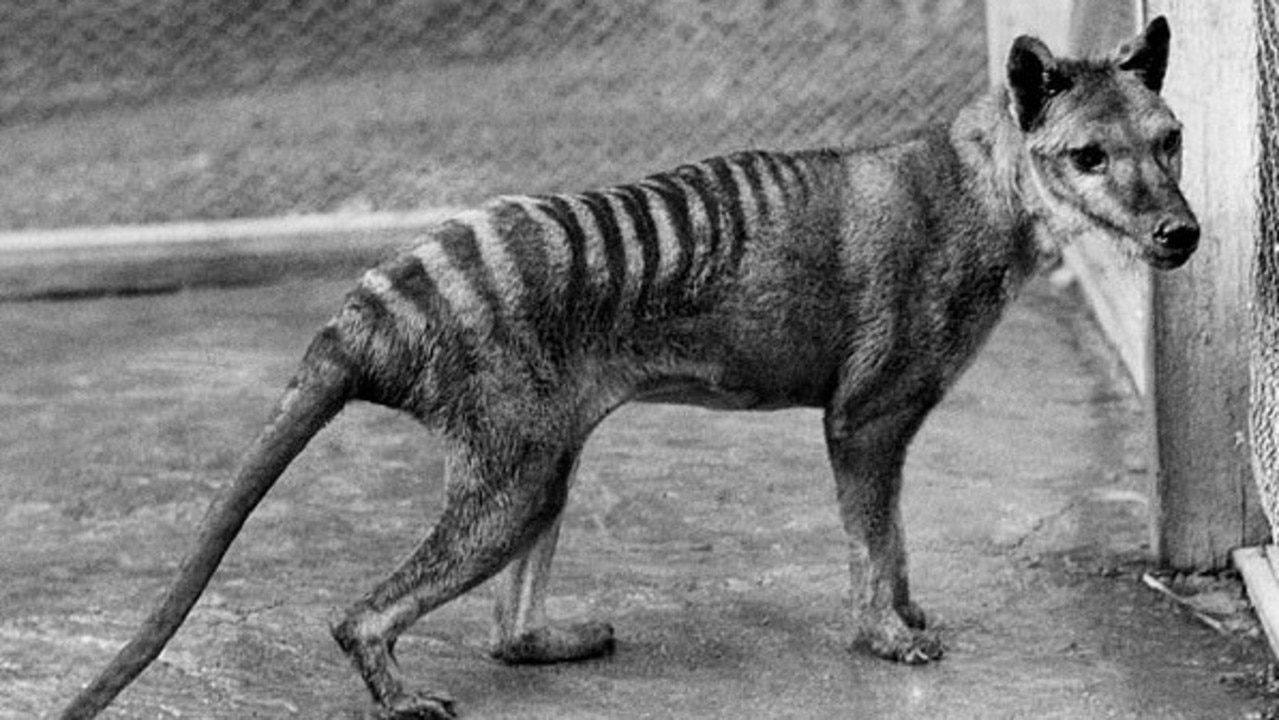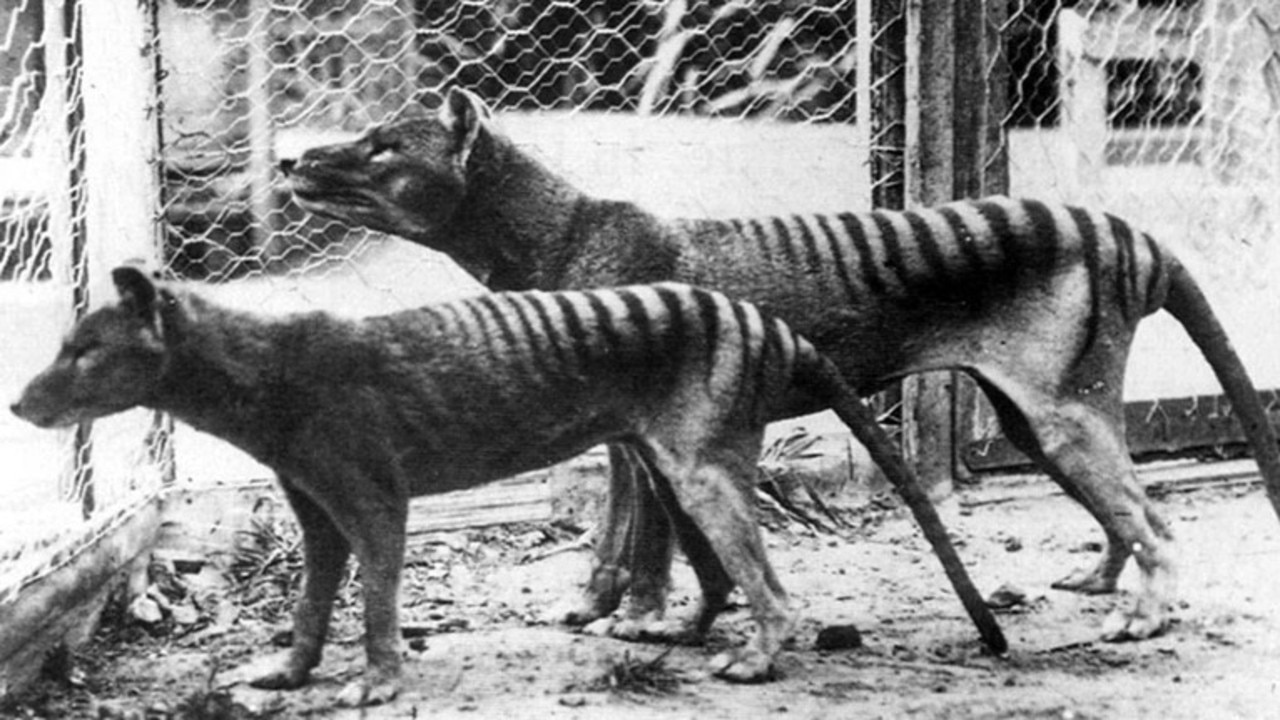Breakthrough in fight to bring back Tasmanian tiger
In a huge breakthrough, researchers have extracted RNA from the extinct Tasmanian tiger, raising hopes we could bring it back.

In a world-first, a group of history-making scientists have extracted RNA from the body of a Tasmanian tiger, reinvigorating the possibility we could bring the extinct marsupial back to life.
The iconic striped carnivore, also known as the thylacine, once roamed the Australian continent, hunting kangaroos and other prey.
Within a century of Europeans landing on Australian soil, the Tasmanian tiger was found only on Tasmania. By 1936, it was extinct.
Heart-wrenching footage showed Benjamin, the last known thylacine, pacing back and forth in his small concrete cage at Hobart Zoo before his lonely death.

Now, in a scientific first, researchers have recovered RNA — genetic material present in all living cells that has structural similarities to DNA — from the century-old body of a Tasmanian tiger.
The RNA was extracted from the desiccated skin and muscle of the specimen, which had been stored at a museum in Stockholm since 1891.
Scientists in recent years have made incredible progress extracting DNA from ancient animals and plants, some of which were more than two million years old. But this study marked the first time RNA, which is much less stable than DNA, was recovered from an extinct species.
Though it was not the focus of the research, the ability to extract, sequence and analyse RNA could be critical in efforts to recreate extinct species.
RNA extraction breakthrough
DNA (deoxyribonucleic acid) and RNA (ribonucleic acid) are biomolecular cousins and fundamental molecules in cell biology.
DNA is a double-stranded molecule that contains an organism’s genetic code. RNA, meanwhile, is a single-stranded molecule that carries genetic information it receives from the DNA and puts it into practice.
In simple terms, RNA codes the proteins that bring DNA to life.
“RNA sequencing gives you a taste of the real biology and metabolism regulation that was happening in the cells and tissues of the Tasmanian tigers before they went extinct,” said geneticist and bioinformatician Emilio Mármol Sánchez of the Centre for Palaeogenetics and SciLifeLab in Sweden, lead author of the study.
“If we want to understand extinct species, we need to understand what gene complements they have and also what the genes were doing and which were active,” added geneticist and study co-author Marc Friedländer.
The researchers extracted and purified 81.9 million and 223.6 million RNA fragments from the thylacine’s muscle and skin, respectively. After removing duplicates and very short sequences, they identified 1.5 million RNA sequences from muscle tissue and 2.8 million RNA sequences from skin.
The researchers found sequences corresponding to more than 500 genes, including ones that code for actin and titin — proteins that enable the muscles to stretch and contract — and for the structural protein keratin.
They also found a small number of RNA molecules belonging to viruses that lived in or infected the Tasmanian tiger.

The tragic extinction of the Tasmanian tiger
The demise of the Tasmanian tiger is considered one of history’s most profound human-driven extinction events, according to the study’s authors.
The thylacine population declined rapidly after the arrival of humans in Australia some 50,000 years ago.
The arrival of European colonisers in the late 18th Century further fuelled their demise before, just 148 years after the arrival of the First Fleet, Tasmanian tigers went extinct.
“Sadly, Tasmanian tigers were declared as protected just two months before the last-known individual died in captivity, too late for saving them from extinction,” Dr Mármol said.
Fight to bring Tasmanian tiger back from extinction
The extraction of DNA — and, now, RNA — from extinct species has raised hopes that humans could one day bring back long-gone species including the Tasmanian tiger, dodo and woolly mammoth.
The study, which was published in Genome Research on Tuesday, confirmed RNA can survive for a very long time even in sub-ideal conditions, such as at room temperature in a museum’s storage cupboard.
The remains at the Swedish Natural History Museum were in a state of semi-mummification, with the skin, muscles and bones preserved but internal organs lost.
“Most researchers have thought that RNA would only survive for a very short time — like days or weeks — at room temperature. This is likely true when samples are wet or moist, but apparently not the case when they are dried,” said evolutionary geneticist Love Dalén of the Centre for Palaeogenetics.
Dr Mármol said his team was “sceptical” about the possibility of actually reviving extinct species, but believed it was important to research the animals regardless.
“Although we remain sceptical about the possibility of actually recreating an extinct species using gene editing on living extant animal relatives — and the timescale to get to a final point might be underestimated — we do advocate for more research on the biology of these extinct animals,” he said.
Get in touch — chloe.whelan@news.com.au






